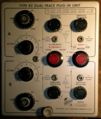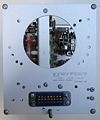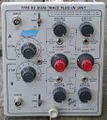82: Difference between revisions
No edit summary |
No edit summary |
||
| Line 21: | Line 21: | ||
==Internals== | ==Internals== | ||
The front end of the Type 82 is a [[7586]] [[nuvistor]] cathode-follower, | The front end of the Type 82 is a [[7586]] [[nuvistor]] cathode-follower, followed by bipolar diff-amps | ||
followed by bipolar diff-amps and diode channel switching, | and diode channel switching, followed by a [[distributed amplifier|distributed output amplifier]] made | ||
followed by a [[distributed amplifier|distributed output amplifier]] made of three [[6DJ8]] tubes, | of three [[6DJ8]] tubes, with differential 93 Ω outputs. | ||
with differential | |||
The use of a distributed amplifier in a plug-in is unusual. | The use of a distributed amplifier in a plug-in is unusual. | ||
Note that the 58x series differs from [[500-series scopes]] mainly in that | Note that the 58x series differs from [[500-series scopes]] mainly in that the vertical | ||
the vertical signal interface between the plug-in and the mainframe is | signal [[580 Series plug-in interface|interface between the plug-in and the mainframe]] | ||
a low controlled impedance (93 ohms), as opposed to other 500-series scopes | is a low controlled impedance (93 ohms), as opposed to other 500-series scopes | ||
that present a high impedance to the plug-in. | that present a high impedance to the plug-in. | ||
| Line 42: | Line 41: | ||
positions were lousey. I think this was fixed on the later 82's as Tek learned | positions were lousey. I think this was fixed on the later 82's as Tek learned | ||
how to make better attenuators. If you have an early 82 and need to look at | how to make better attenuators. If you have an early 82 and need to look at | ||
high frequency signals on the less sensitive ranges, the answer is to | high frequency signals on the less sensitive ranges, the answer is to get ×100 | ||
probes and use them on the more sensitive ranges where the frequency response is | probes and use them on the more sensitive ranges where the frequency response is | ||
better. | better. | ||
| Line 52: | Line 51: | ||
<gallery> | <gallery> | ||
File:82_front.jpg|Front view, early style | File:82_front.jpg|Front view, early style | ||
File:82_left.jpg|Left view | File:82_left.jpg|Left view | ||
File:82_top.jpg|Top view | File:82_top.jpg|Top view | ||
File:82_right.jpg|Right view | File:82_right.jpg|Right view | ||
File:Type 82 top.jpg | File:Type 82 top.jpg | ||
Revision as of 10:35, 29 April 2018
The Tektronix Type 82 is a dual-trace plug-in for the 580-series scopes. The Type 82 combined with a 585 or 585A provides a 4 nanosecond risetime (85 MHz bandwidth).
Key Specifications
| Rise time | 4 ns in ×1 mode, 4.3 ns in ×10 mode (in 585 mainframe) |
|---|---|
| Bandwidth | 85 MHz in ×1 mode, 80 MHz in ×10 mode (in 585 mainframe); 70 MHz/66 MHz, respectively, with P6008 probe |
| Deflection | 50 V/Div to 100 mV/Div in ×1 mode, 50 V/Div to 100 mV/Div in ×10 mode (1-2-5) |
Internals
The front end of the Type 82 is a 7586 nuvistor cathode-follower, followed by bipolar diff-amps and diode channel switching, followed by a distributed output amplifier made of three 6DJ8 tubes, with differential 93 Ω outputs.
The use of a distributed amplifier in a plug-in is unusual. Note that the 58x series differs from 500-series scopes mainly in that the vertical signal interface between the plug-in and the mainframe is a low controlled impedance (93 ohms), as opposed to other 500-series scopes that present a high impedance to the plug-in.
Stan Griffiths wrote:
If you feed [a fast risetime] signal into an early type 82, you will find that the top three least sensitive positions have really terrible frequency response ... so bad, in fact, that some customers thought they were broken. When told this was normal, these customers wondered why Tek ever included them on the plugin. The answer was that they were still useful for low frequency signals ... but Tek never really made it well known that these 82 attenuator positions were lousey. I think this was fixed on the later 82's as Tek learned how to make better attenuators. If you have an early 82 and need to look at high frequency signals on the less sensitive ranges, the answer is to get ×100 probes and use them on the more sensitive ranges where the frequency response is better.
The P6008 voltage probe was designed for use with the Type 82.
Pictures
-
Front view, early style
-
Left view
-
Top view
-
Right view
-
-
-
-
-
Bottom of distributed amplifier
-
Top of distributed amplifier
-
Front view, later style










